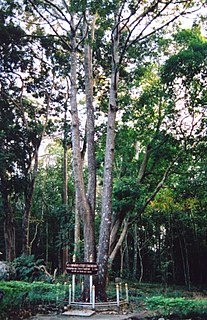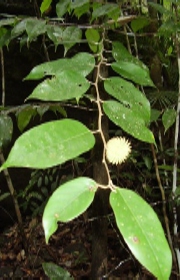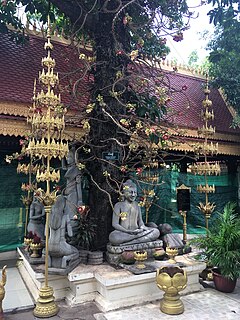
Shorea is a genus of about 196 species of mainly rainforest trees in the family Dipterocarpaceae. The genus is named after Sir John Shore, the governor-general of the British East India Company, 1793–1798. The timber of trees of the genus is sold under the common names lauan, luan, lawaan, meranti, seraya, balau, bangkirai, and Philippine mahogany.
Shorea teysmanniana is a timber tree of the family Dipterocarpaceae. It occurs in Sumatra, Peninsular Malaysia and Borneo.
Shorea acuminata is a species of plant in the family Dipterocarpaceae. It grows naturally in Sumatra and Peninsular Malaysia.
Shorea almon is a species of plant in the family Dipterocarpaceae. It is native to Borneo and the Philippines.

Shorea astylosa is a species of plant in the family Dipterocarpaceae. It is endemic to the Philippines, where it is known as yakal in the Filipino language.
Shorea balangeran, called red balau, is a species of plant in the family Dipterocarpaceae. It is native to Sumatra and Borneo. It is a Vulnerable species threatened by habitat loss.

Shorea contorta is a species of plant in the family Dipterocarpaceae. It is endemic to the Philippines.
Shorea falciferoides, also known as yakal yamban in the Philippines, is a species of plant in the family Dipterocarpaceae. It is found in Borneo and the Philippines. It is threatened by habitat loss.
Guijo is a species of plant in the family Dipterocarpaceae. It is a tree found in Cambodia, Laos, Vietnam, Sumatra, Peninsular Malaysia, Borneo and the Philippines. The name guijo is a Philippine Spanish word derived from the Tagalog gihò. This is also sometimes known as red balan or red balau sharing its name with Shorea balangeran. Other local names include yamban-yamban in Zambales and taralai in Tarlac.
Shorea hopeifolia is a species of plant in the family Dipterocarpaceae. It is a tree found in Sumatra, Peninsular Malaysia, Borneo and the Philippines.
Shorea malibato is a species of plant in the family Dipterocarpaceae. It is endemic to the Philippines.
Shorea negrosensis is a species of plant in the family Dipterocarpaceae. It is endemic to the Philippines.
Shorea ovata is a species of plant in the family Dipterocarpaceae. It is a tree found in Sumatra, Peninsular Malaysia, Borneo and the Philippines. It is threatened by habitat loss.
Shorea palosapis is a flowering plant in the Dipterocarpaceae family. It is commonly called Philippine Mahogany or White Lauan. It is endemic to the Philippines. It is threatened by habitat loss which stems from recent human involvement in its natural habitat.
Shorea pauciflora is a species of plant in the family Dipterocarpaceae. It is found in Sumatra, Peninsular Malaysia and Singapore. It is threatened by habitat loss. The specific epithet pauciflora is Latin for 'few-flowered'.
Shorea rugosa, called dark red meranti, is a species of plant in the family Dipterocarpaceae. It is native to Borneo and Sumatra. It is a Vulnerable species threatened by habitat loss.

Shorea siamensis is a species of tree in the family Dipterocarpaceae. It is native to most of mainland Southeast Asia.

The Amro River Protected Landscape is a protected landscape area located in the province of Aurora in eastern Central Luzon in the Philippines. It preserves the primary water source for agricultural, power generation and domestic consumption of the remote northern Auroran communities on the Pacific coast. The area was first established in 1990 as the Amro River Watershed Forest Reserve to protect, maintain and improve the water yield of the Amro River as declared through Proclamation No. 633 by President Corazón Aquino. In 2000, the forest reserve was reclassified as a protected landscape under the National Integrated Protected Areas System with the enactment of Proclamation No. 274 by President Joseph Estrada. It is one of five declared protected areas of the Philippines in Aurora.

The Simbahan–Talagas Protected Landscape is a protected area in northern Aurora, Philippines that preserves a major watershed in the Sierra Madre mountain range of Central Luzon. It contains the headwaters of the Simbahan and Talagas rivers, including the Sangay River and Umihiem Creek in Dinalungan municipality which empty into the Casiguran Sound. A large portion of the park is under forest cover, while the remaining areas are cultivated land, shrubland, grassland, built-up area and river-wash area. Some of the park's fauna include the Philippine deer, Philippine long-tailed macaque, and an abundant species of avifauna. Its location in north central Sierra Madre is covered by dipterocarp forest, composed of Shorea almon, Shorea polysperma (tanguile), Shorea squamata (mayapis), Shorea contorta, Shorea negrosensis, and Parashorea malaanonan (bagtikan).

The Talaytay Protected Landscape is a protected area in northern Aurora, Philippines that preserves the Talaytay River watershed in the Sierra Madre mountain range of Central Luzon. It encompasses an area of 3,526.29 hectares stretching from the rugged interior containing the headwaters of the Talaytay River to its mouth at the lowland area of Dinalungan municipality. The park is known to harbor several important flora of the dipterocarp variety, including Dipterocarpus grandiflorus (apitong), Shorea polysperma (tanguile), Shorea squamata (mayapis), Shorea contorta, Shorea negrosensis, Parashorea malaanonan (bagtikan), and Shorea philippinensis (mangasinoro). It is home to a number of wildlife such as the Philippine deer, Philippine long-tailed macaque and some avifauna species.






